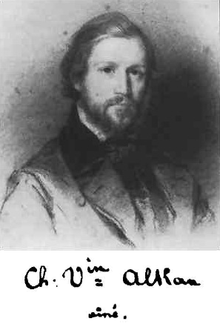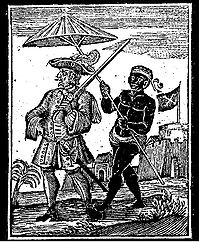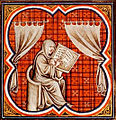Portal:Biography
The Biography Portal
A biography, or simply bio, is a detailed description of a person's life. It involves more than just basic facts like education, work, relationships, and death; it portrays a person's experience of these life events. Unlike a profile or curriculum vitae (résumé), a biography presents a subject's life story, highlighting various aspects of their life, including intimate details of experience, and may include an analysis of the subject's personality.
Biographical works are usually non-fiction, but fiction can also be used to portray a person's life. One in-depth form of biographical coverage is called legacy writing. Works in diverse media, from literature to film, form the genre known as biography.
An authorized biography is written with the permission, cooperation, and at times, participation of a subject or a subject's heirs. An autobiography is written by the person themselves, sometimes with the assistance of a collaborator or ghostwriter. (Full article...)
Featured biographies –
Air Marshal Sir Peter Roy Maxwell Drummond, KCB, DSO & Bar, OBE, MC (2 June 1894 – 27 March 1945) was an Australian-born senior commander in the Royal Air Force (RAF). He rose from private soldier in World War I to air marshal in World War II. Drummond enlisted in the Australian Imperial Force in 1914 and the following year saw service as a medical orderly during the Gallipoli campaign. He joined the Royal Flying Corps in 1916 and became a fighter ace in the Middle Eastern theatre, where he was awarded the Military Cross and the Distinguished Service Order and Bar. Transferring to the RAF on its formation in 1918, he remained in the British armed forces for the rest of his life.
Between the wars, Drummond saw action in the Sudan—earning appointment as an Officer of the Order of the British Empire—and was posted to Australia on secondment to the Royal Australian Air Force (RAAF) as Director of Operations and Intelligence. In Britain, he commanded RAF stations Tangmere and Northolt. Ranked air commodore at the outbreak of World War II, he was Air Marshal Sir Arthur Tedder's Deputy Air Officer Commanding-in-Chief RAF Middle East from 1941 to 1943. Drummond was appointed a Companion of the Order of the Bath in 1941 for his services in the Middle East, and knighted in the same order two years later. He was twice offered command of the RAAF during the war but the RAF was unwilling to release him to take up the position. Britain's Air Member for Training from 1943, Drummond was killed in a plane crash at sea in 1945. (Full article...)
Haane Te Rauawa Manahi, DCM (28 September 1913 – 29 March 1986) was a New Zealand Māori soldier during the Second World War whose gallantry during the Tunisian campaign resulted in a recommendation that he be awarded the Victoria Cross (VC). The subsequent award of the Distinguished Conduct Medal (DCM) disappointed his fellow soldiers who, after his death, advocated greater recognition of his valour. This eventually resulted in a special award in 2007 of an altar cloth for use in a local church, ceremonial sword and a personal letter from Queen Elizabeth II in recognition of his gallantry.
Born in Ohinemutu, New Zealand, Manahi worked as a labourer when, in November 1939, he volunteered to join the Māori Battalion, newly raised for service in the Second World War. In 1941, he participated in the Battle of Greece and fought in the Battle of Crete during which he was wounded. After recovering from his wounds, he returned to his unit and fought through the Western Desert and Tunisian campaigns, during which he was recommended for a VC for his actions at Takrouna over the period 19–21 April 1943. Despite the support of four generals, his VC nomination was downgraded to an award of a DCM, possibly by the British Chief of the General Staff, General Alan Brooke. (Full article...)

Sir Edward William Elgar, 1st Baronet, OM, GCVO (⫽ˈɛlɡɑːr⫽ ; 2 June 1857 – 23 February 1934) was an English composer, many of whose works have entered the British and international classical concert repertoire. Among his best-known compositions are orchestral works including the Enigma Variations, the Pomp and Circumstance Marches, concertos for violin and cello, and two symphonies. He also composed choral works, including The Dream of Gerontius, chamber music and songs. He was appointed Master of the King's Musick in 1924.
Although Elgar is often regarded as a typically English composer, most of his musical influences were not from England but from continental Europe. He felt himself to be an outsider, not only musically, but socially. In musical circles dominated by academics, he was a self-taught composer; in Protestant Britain, his Roman Catholicism was regarded with suspicion in some quarters; and in the class-conscious society of Victorian and Edwardian Britain, he was acutely sensitive about his humble origins even after he achieved recognition. He nevertheless married the daughter of a senior British Army officer. She inspired him both musically and socially, but he struggled to achieve success until his forties, when after a series of moderately successful works his Enigma Variations (1899) became immediately popular in Britain and overseas. He followed the Variations with a choral work, The Dream of Gerontius (1900), based on a Roman Catholic text that caused some disquiet in the Anglican establishment in Britain, but it became, and has remained, a core repertory work in Britain and elsewhere. His later full-length religious choral works were well received but have not entered the regular repertory. (Full article...)
Martin Rundkvist (born 4 April 1972) is a Swedish archaeologist and associate professor at the University of Łódź in Poland. His research focuses on the Bronze, Iron, and Middle Ages of Scandinavia, including significant excavations in the province of Östergötland.
Rundkvist has studied and excavated various sites in Sweden, particularly in the country's south. In 2003 and 2004, he published a three-volume work which doubled as his PhD dissertation, cataloguing the finds from Barshalder, the largest prehistoric cemetery on the Swedish island of Gotland. A subsequent book identified nine possible regional power centres in Östergötland, and attempted to determine where the "Beowulfian mead halls" of the day once stood. Excavating years later at one of these sites, Aska, Rundkvist uncovered the foundations of a large mead hall, and 30 ornate gold figures that might have represented gods or royals. In other works, Rundkvist has excavated a Viking boat grave, and analysed both the placement of deposited artefacts in the landscape and the lifestyles of the Scandinavian élite during the Middle Ages. (Full article...)

Charles-Valentin Alkan (French: [ʃaʁl valɑ̃tɛ̃ alkɑ̃]; 30 November 1813 – 29 March 1888) was a French composer and virtuoso pianist. At the height of his fame in the 1830s and 1840s he was, alongside his friends and colleagues Frédéric Chopin and Franz Liszt, among the leading pianists in Paris, a city in which he spent virtually his entire life.
Alkan earned many awards at the Conservatoire de Paris, which he entered before he was six. His career in the salons and concert halls of Paris was marked by his occasional long withdrawals from public performance, for personal reasons. Although he had a wide circle of friends and acquaintances in the Parisian artistic world, including Eugène Delacroix and George Sand, from 1848 he began to adopt a reclusive life style, while continuing with his compositions – virtually all of which are for the keyboard. During this period he published, among other works, his collections of large-scale studies in all the major keys (Op. 35) and all the minor keys (Op. 39). The latter includes his Symphony for Solo Piano (Op. 39, nos. 4–7) and Concerto for Solo Piano (Op. 39, nos. 8–10), which are often considered among his masterpieces and are of great musical and technical complexity. Alkan emerged from self-imposed retirement in the 1870s to give a series of recitals that were attended by a new generation of French musicians. (Full article...)

Carl Hans Lody, alias Charles A. Inglis (20 January 1877 – 6 November 1914; name occasionally given as Karl Hans Lody), was a reserve officer of the Imperial German Navy who spied in the United Kingdom in the first few months of the First World War.
In May 1914, two months before the start of World War 1, Lody was approached by German naval intelligence officials. He agreed to be a peacetime spy in southern France, but after war broke out, in late August he was sent to the United Kingdom with orders to spy on the Royal Navy. Lody had been given no training in espionage, and within only a few days of arriving he was detected by the British authorities. The British counter-espionage agency MI5, then known as MO5(g), allowed him to continue his activities in the hope of learning more about the German spy network. His first two messages were allowed to reach the Germans, but later messages were stopped, as they contained sensitive military information. At the start of October 1914, concern over the increasingly sensitive nature of his messages prompted MO5(g) to order his arrest. (Full article...)
Sir Thomas Walter White, KBE, DFC, VD (26 April 1888 – 13 October 1957) was an Australian politician and pilot in the First World War. In 1914 he became one of the first airmen trained for the Australian Flying Corps (AFC), and the following year he was among the first AFC members to see action when he was deployed to the Middle East with the Mesopotamian Half Flight. After carrying out several missions behind Turkish lines, he was captured in November 1915 but escaped in July 1918. White was awarded the Distinguished Flying Cross and twice mentioned in despatches for his war service. He married Vera Deakin, a Red Cross worker and daughter of former Australian prime minister Alfred Deakin, in 1920.
White began his parliamentary career in 1929 when he was elected to the House of Representatives as the Member for Balaclava in Victoria. He served as Minister for Trade and Customs in Joseph Lyons's United Australia Party government from 1933 to 1938, but resigned when he was excluded from Lyons's inner cabinet. He joined the Royal Australian Air Force (RAAF) shortly after the outbreak of the Second World War and saw service in Australia and the United Kingdom. Returning to parliament as a member of the newly formed Liberal Party in 1945, he served as Minister for Air and Minister for Civil Aviation in Robert Menzies's government from 1949 to 1951. His term coincided with the commitment of RAAF squadrons to the Korean War and the Malayan Emergency. Australia's high commissioner to the United Kingdom from 1951 to 1956, White was knighted in 1952 and died in 1957. (Full article...)
James Thompson (1789 – October 6, 1872) was an American surveyor who created the first plat of Chicago. Born in South Carolina, Thompson moved to Kaskaskia in southern Illinois as a young man and lived in the area for the rest of his life, working primarily as a surveyor. He was hired to plat settlements at the ends of the proposed Illinois and Michigan Canal in northern Illinois; he completed the plat of Chicago, the settlement at the eastern end, on August 4, 1830. After completing his survey of Chicago he returned to the Kaskaskia area and declined an offer of land in Chicago in favor of a cash payment. In addition to his surveying work, he served in various positions such as probate judge, county commissioner, and officer in the Illinois militia during the Black Hawk War.
Chicago appears on maps from the 17th century and had been inhabited by non-indigenous people since the late 18th century. Thompson's plat fixed the location associated with the word "Chicago", which had previously been used for various places around the southwestern shore of Lake Michigan, and allowed the residents of the area to obtain legal title to their property. Extensions of Thompson's plat were made in the following years as Chicago experienced rapid expansion. Chicago incorporated as a town in 1833 and as a city in 1837 as growth continued, and by 1890 had more than a million inhabitants and was the second-most-populous city in the United States. Thompson has been commemorated several times in Chicago's history; his grave, which was originally unmarked, was given a monument by the city of Chicago in 1917. (Full article...)
Ioannis Agorastos "John" Plagis, DSO, DFC & Bar (1919–1974) was a Southern Rhodesian flying ace in the Royal Air Force (RAF) during the Second World War, noted especially for his part in the defence of Malta during 1942. The son of Greek immigrants, he was accepted by recruiters only after Greece joined the Allies in late 1940. Following spells with No. 65 Squadron and No. 266 (Rhodesia) Squadron, he joined No. 249 (Gold Coast) Squadron in Malta in March 1942. Flying Spitfire Mk Vs, Plagis was part of the multinational group of Allied pilots that successfully defended the strategically important island against numerically superior Axis forces over the next few months. Flying with No. 185 Squadron from early June, he was withdrawn to England in early July 1942.
After a spell as an instructor in the UK, Plagis returned to action in September 1943 as commander of No. 64 Squadron, flying Spitfire Mk VCs over northern France. He took command of No. 126 (Persian Gulf) Squadron in June 1944, and led many attacks on German positions during the invasion of France and the campaign that followed; he was shot down over Arnhem during Operation Market Garden, but only lightly wounded. After converting to Mustang IIIs, he commanded a wing based at RAF Bentwaters that supported bombing missions. He finished the war with the rank of squadron leader and remained with the RAF afterwards, operating Gloster Meteors at the head of No. 266 (Rhodesia) Squadron. (Full article...)














































